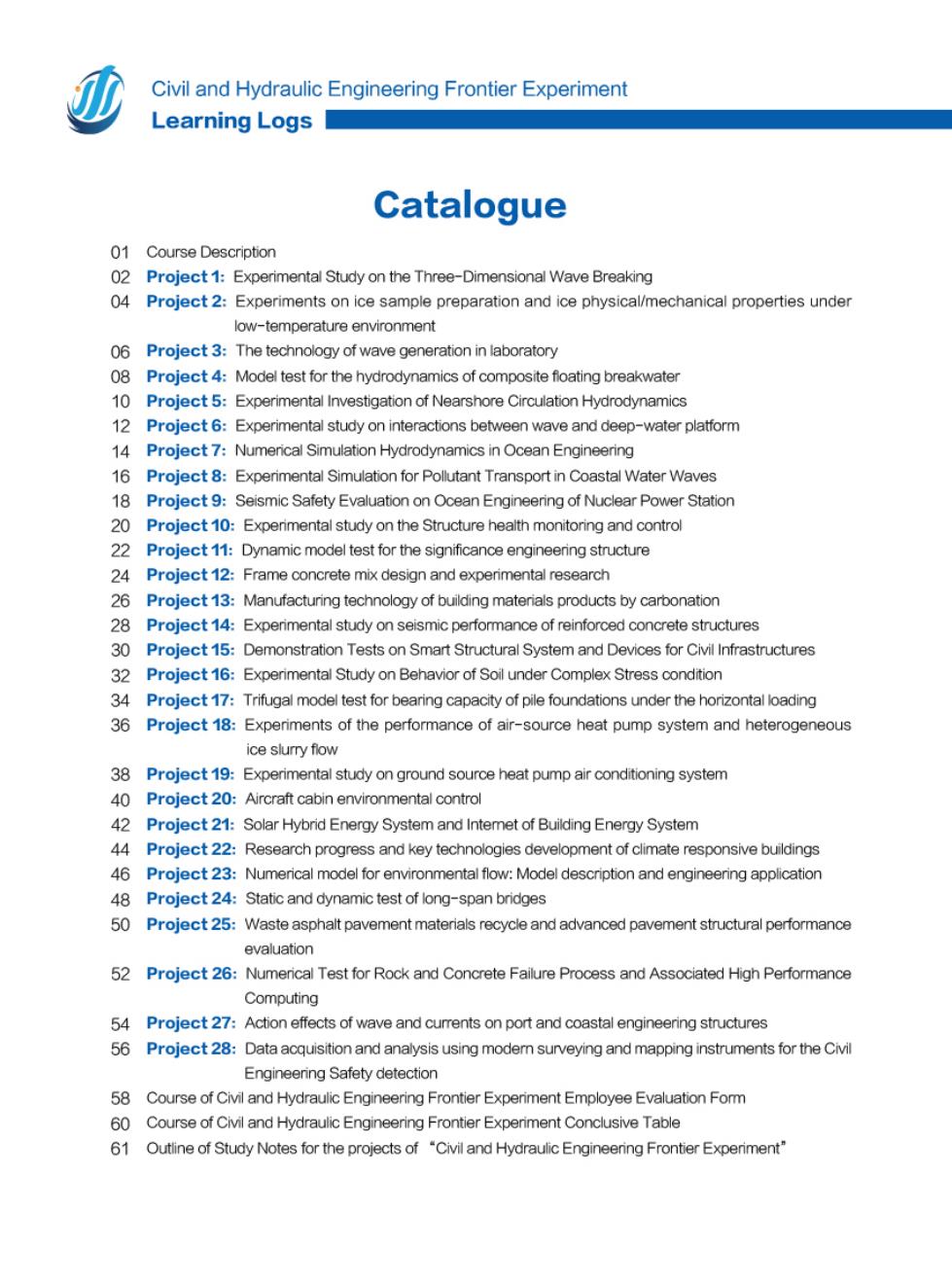
Civil and Hydraulic Engineering Frontier Experiment Learning Logs Catalogue 01 Course Description 02 Project1:Experimental Study on the Three-Dimensional Wave Breaking 04 Project2:Experiments on ice sample preparation and ice physical/mechanical properties unde low-temperature environment 06 Project 3:The technology of wave generation in laboratory 08Project4:Model test for the hydrodynamics of breakwater 10 Project5:Experimental Investigation of Nearshore Circulation Hydrodynamics 12 Project 6:Experimental study on interactions between wave and deep-water platform 14 Proiect 7:Numerical Simulation Hydrodynamics in Ocean Engineering 16Project:Experimental Simulation for Pollutant Transport in Coastal Water Wave 18 Project 9:Seismic Safety Evaluation on Ocean Engineering of Nuclear Power Station 20 Project 10:Experimental study on the Structure health monitoring and control 22 Project11:Dynamic model testfor the significance engineenng structure 24 Project12:Frame concrete mix design and experimental research 26 Project 13:Manufacturing technology of bulding materials products by carbonation 28 Project 14:Experimental study on seismic performance of reinforced concrete structures 30 Project15:Demonstration Tests on Smart Structural System and Devices for Civil Infrastructures 32 Project 16:Experimental Study on Behavior of Soil under Complex Stress condition 34 Project 17:Trifugal model test for bearing capacity of pile foundations under the horizontal loading 36 Project 18:Experiments of the performance of air-source heat pump system and heterogeneous 38 Project 19:Experimental study on ground source heat pump air conditioning system 40 Proiect 20:Aircraft cabin environmental control 42 Project2:Solar Hybrid Energy System and Intemet of Bulding Energy System 44 Project 22:Research progress and key technologies development of climate responsive buildings 46 Project 23:Numerical model for environmental flow:Model description and engineering application 48 Project 24:Static and dynamic test of long-span bridges 50 Project 25:Waste asphalt pavement materials recycle and advanced pavement structural performance evaluation 52 Project 26:Numerical Test for Rock and Concrete Failure Process and Associated High Performance Computing 54 Project 27:Action effects of wave and currents on port and coastal engineering structures 56 Proiect 28:Data acquisition and analysis using modemn surveying and mapping instruments for the Civi Engineering Safety detection 58 Course of CMvl and Hydraulic Engineering Frontier Experiment Employee Evaluation Fom 60 Course of Civil and Hydraulic Engineering Frontier Experiment Conclusive Table 61 Outine of Study Notes for the projects of "Civil and HydrauicEngineering Frontier Experiment
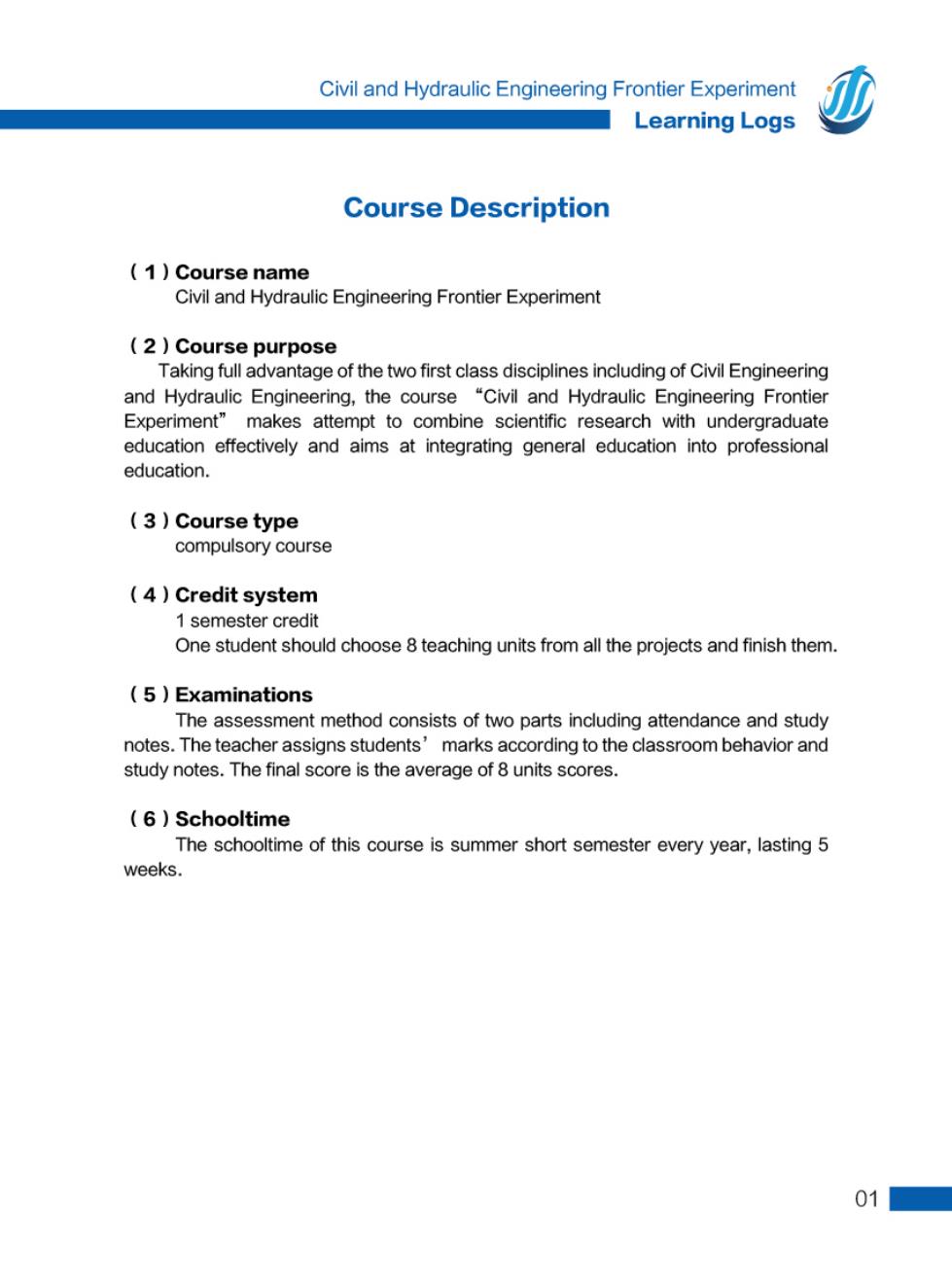
Civil and Hydraulic Engineering Frontier Experiment Learning Logs Course Description (1)Course name Civil and Hydraulic Engineering Frontier Experiment (2)Course purpose Taking full advantage of the two first class disciplines including of Civil Engineering and Hydraulic Engineering,the course "Civil and Hydraulic Engineering Frontie Experiment" makes attempt to combine scientific research with undergraduate education effectively and aims at integrating general education into professional education. (3)Course type compulsory course (4 )Credit system 1 semester credit One student should choose 8 teaching units from all the projects and finish them (5)Examinations The assessment method consists of two parts including attendance and study notes.The teacher assigns students'marks according to the classroom behavior and study notes.The final score is the average of 8 units scores. (6)Schooltime The schooltime of this course is summer short semester every year,lasting 5 weeks. 01
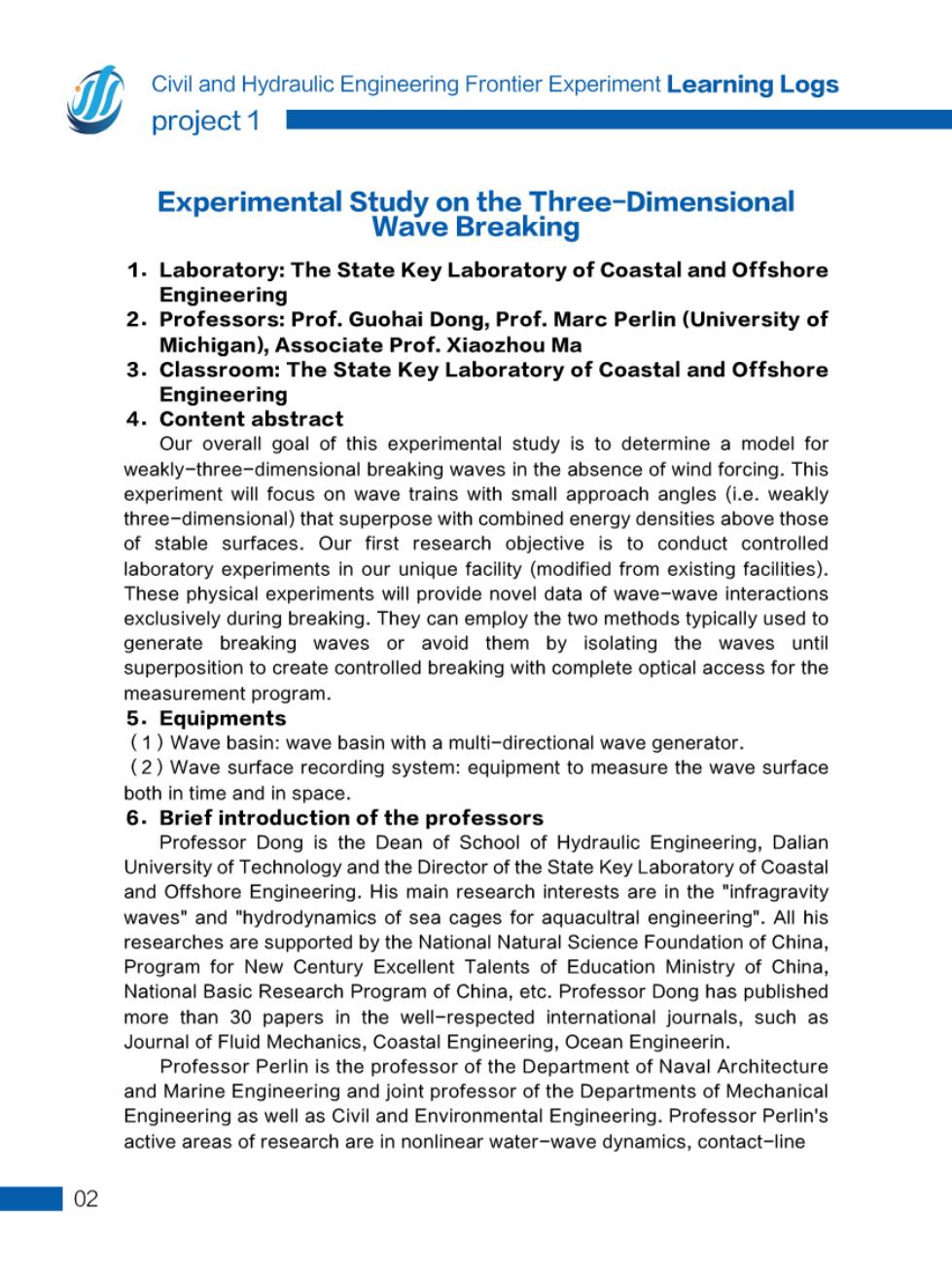
Civil and Hydraulic Engineering Frontier Experiment Learning Logs project 1 Experimental Study on the Three-Dimensional Wave Breaking 1.Laboratory:The State Key Laboratory of Coastal and Offshore Engineering 2.Professors:Prof.Guohai Dong,Prof.Marc Perlin(University of Michigan),Associate Prof.Xiaozhou Ma 3.Classroom:The State Key Laboratory of Coastal and Offshore Engineering 4.Content abstract Our overall goal of this experimental study is to determine a model for weakly-three-dimensional breaking waves in the absence of wind forcing.This experiment will focus on wave trains with small approach angles (i.e.weakly three dimensional)that superpose with combined energy densities above thos of stable surfaces.Our first research objective is to conduct controlled laboratory experiments in our unique facility (modified from existing facilities). These physical experiments will provide novel data of wave-wave interactions exclusively during breaking.They can employ the two methods typically used to generate breaking waves or avoid them by isolating the waves until superposition to create controlled breaking with complete optical access for the measurement program 5.Equipments (1 )Wave basin:wave basin with a multi-directional wave generator. (2)Wave surface recording system:equipment to measure the wave surface both in time and in space. 6.Brief introduction of the professors Professor Dong is the Dean of School of Hydraulic Engineering,Dalian University of Technology and the Director of the State Key Laboratory of Coastal and Offshore Engineering.His main research interests are in the "infragravity waves"and "hydrodynamics of sea cages for aquacultral engineering".All his researches are supported by the Natior nal Natural Science Foundation of China, Program for New Century Excellent Talents of Education Ministry of China National Basic Research Program of China,etc.Professor Dong has published more than 30 papers in the well-respected international journals,such as Journal of Fluid Mechanics,Coastal Engineering,Ocean Engineerin Professor Perlin is the professor of the Department of Naval Architecture and Marine Engineering and joint professor of the Departments of Mechanical Engineering as well as Civil and Environmental Engineering.Professor Perlin's active areas of research are in nonlinear water-wave dynamics,contact-line 02
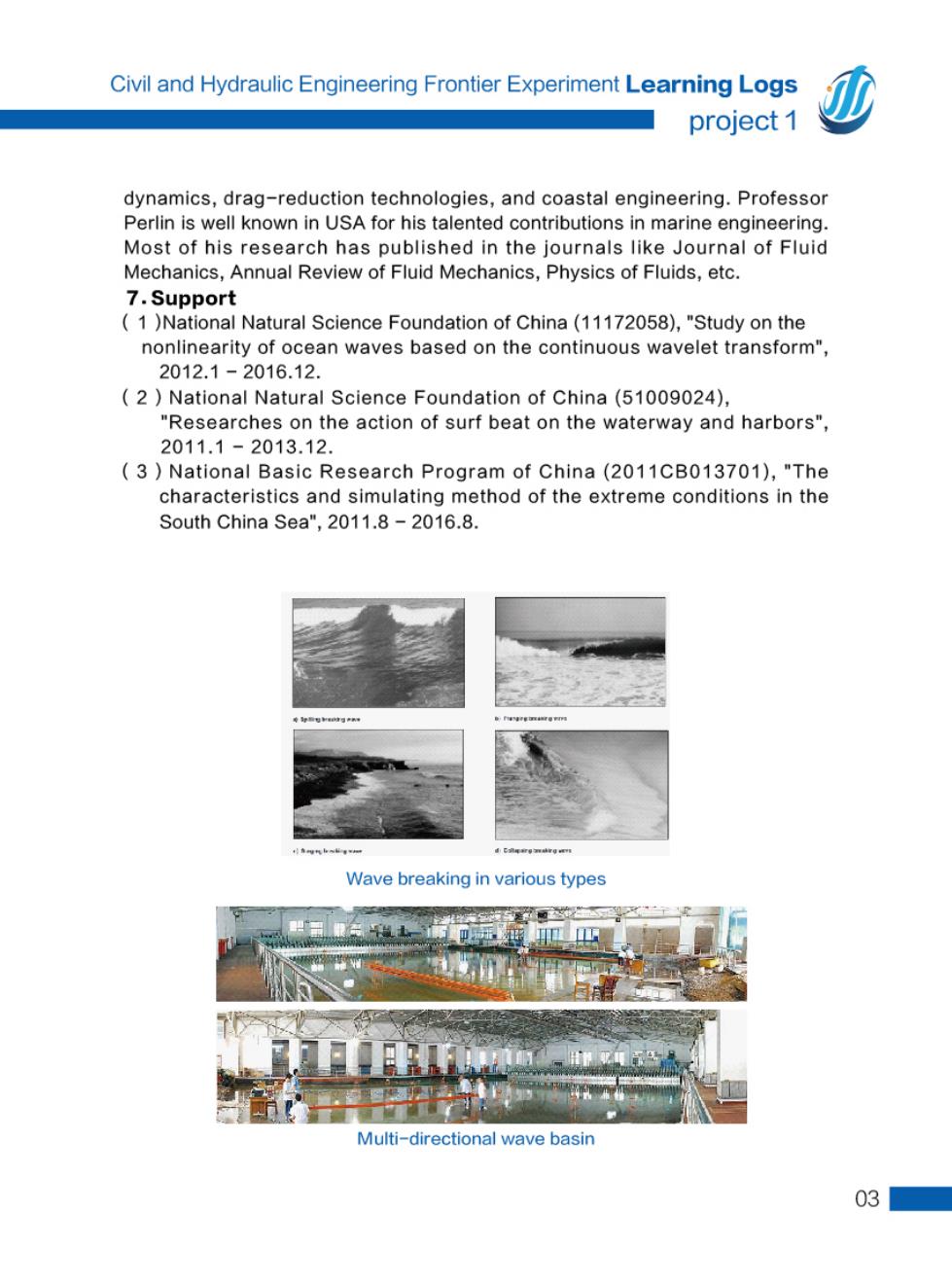
Civil and Hydraulic Engineering Frontier Experiment Learning Logs project 1 dynamics,drag-reduction technologies,and coastal engineering.Professor Perlin is well known in USA for his talented contributions in marine engineering Most of his research has published in the journals like Journal of Fluid Mechanics,Annual Review of Fluid Mechanics,Physics of Fluids,etc. 7.Support (1)National Natural Science Foundation of China(11172058),"Study on the nonlinearity of ocean waves based on the continuous wavelet transform", 2012.1-2016.12. (2 )National Natural Science Foundation of China(51009024). "Researches on the action of surf beat on the waterway and harbors", 2011.1-2013.12. (3)National Basic Research Program of China(2011CB013701),"The characteristics and simulating method of the extreme conditions in the South China Sea",2011.8-2016.8. Wave breaking in various types Multi-directional wave basin 03■
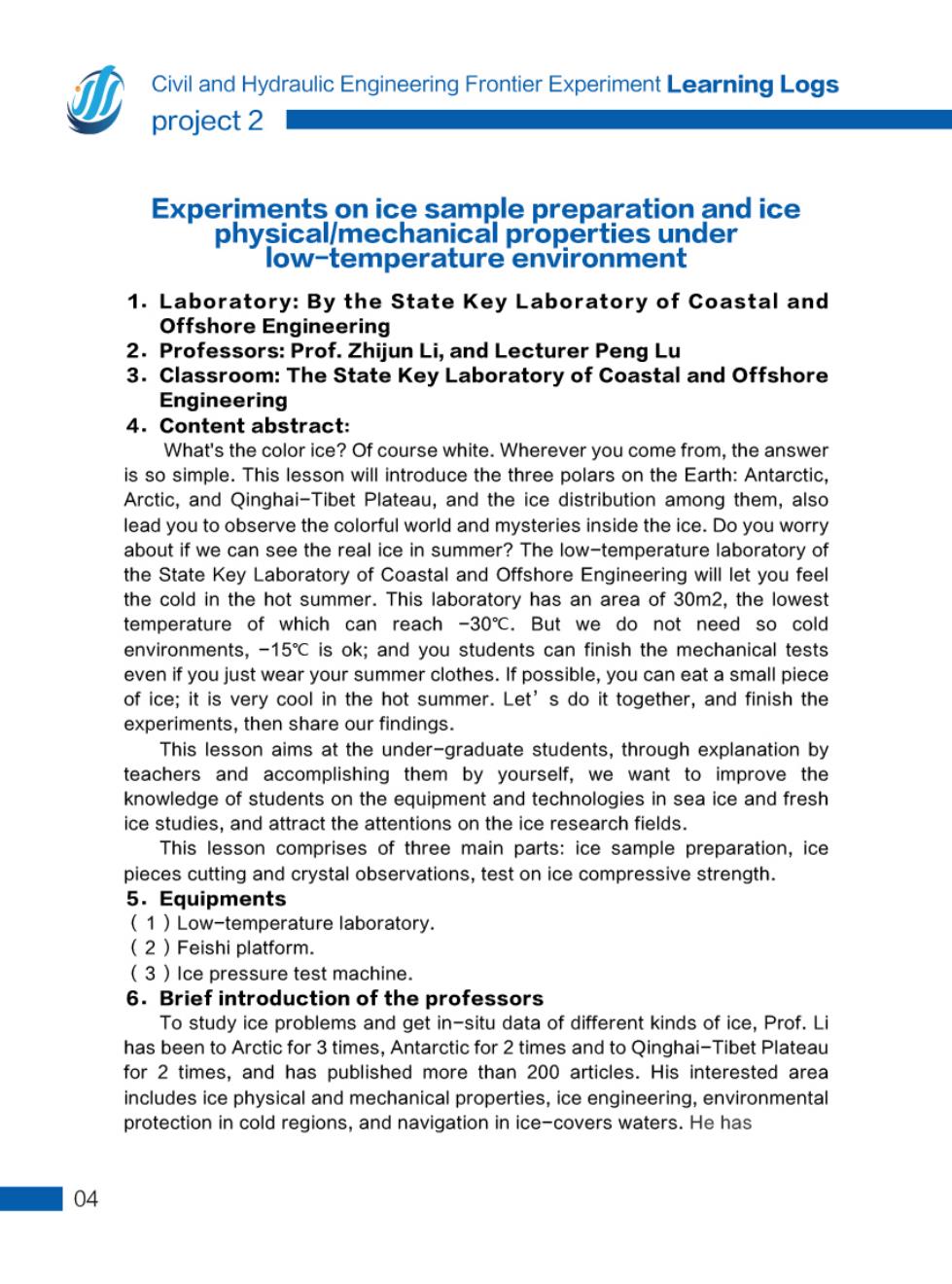
Civil and Hydraulic Engineering Frontier Experiment Learning Logs project2■ Experiments on ice sample preparation and ice physical/mechanical properties under low-temperature environment 1.Laboratory:By the State Key Laboratory of Coastal and Offshore Engineering 2.Professors:Prof.Zhijun Li,and Lecturer Peng Lu 3.Classroom:The State Key Laboratory of Coastal and Offshore Engineering 4.Content abstract: What's the color ice?Of course white.Wherever you come from,the answer is so simple.This lesson will introduce the three rs on the Earth:Antarctic. Arctic,and Qinghai-Tibet Plateau,and the ice distribution among them,also lead you to observe the colorful world and mysteries inside the ice.Do you worry about if we can see the real ice in summer?The low-temperature laboratory of the State Key Laboratory of Coastal and Offshore Engineering will let you feel the cold in the hot summer.This laboratory has an area of 30m2,the lowest temperature of which can reach -30C.But we do not need so cold environments, -15C is ok;and you students can finish the mechanical tests even if you just wear your summer clothes.If possible,you can eat a small piece of ice;it is very cool in the hot summer.Let's do it together,and finish the experiments,then share our findings. This lesson aims at the under-graduate students,through explanation by teachers and accomplishing them by yourself,we want to improve the knowledge of students on the equipment and technologies in sea ice and fresh ice studies,and attract the attentions on the ice research fields This lesson comprises of three main parts:ice sample preparation,ice pieces cutting and crystal observations,test on ice compressive strength. 5.Equipments 1)Low-temperature laboratory. (2 Feishi platform. 3 lce pressure test machine 6.Brief introduction of the professors To study ice problems and get in-situ data of different kinds of ice,Prof.Li has been to Arctic for 3 times,Antarctic for 2 times and to Qinghai-Tibet Plateau for 2 times,and has published more than 200 articles.His interested area includes ice physical and mechanical properties,ice engineering,environmental protection in cold regions,and navigation in ice-covers waters.He has 04